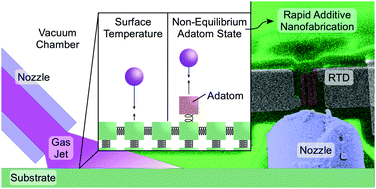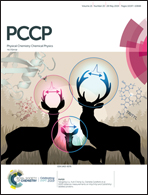Non-equilibrium adatom thermal state enables rapid additive nanomanufacturing†
Abstract
A new state of radical thermal non-equilibrium in surface adsorbed molecules is discovered that enables rapid surface diffusion of energized adatoms with a negligible effect on the substrate surface temperature. Due to enhanced surface diffusion, growth rates can be achieved that improve the feasibility of many nanofabrication techniques. Since the adatom temperature cannot be directly measured without disturbing its thermodynamic state, the first principle hard-cube model is used to predict both the adatom effective temperature and the surface temperature in response to gaseous particle impingement in a vacuum. The validity of the approach is supported by local, spatially-resolved surface temperature measurements of the thermal response to supersonic microjet gas impingement. The ability to determine and control the adatom effective temperature, and therefore the surface diffusion rate, opens new degrees of freedom in controlling a wide range of nanofabrication processes that critically depend on surface diffusion of precursor molecules. This fundamental understanding has the potential to accelerate research into nanoscale fabrication and to yield the new materials with unique properties that are only accessible with nanoscale features.



 Please wait while we load your content...
Please wait while we load your content...
